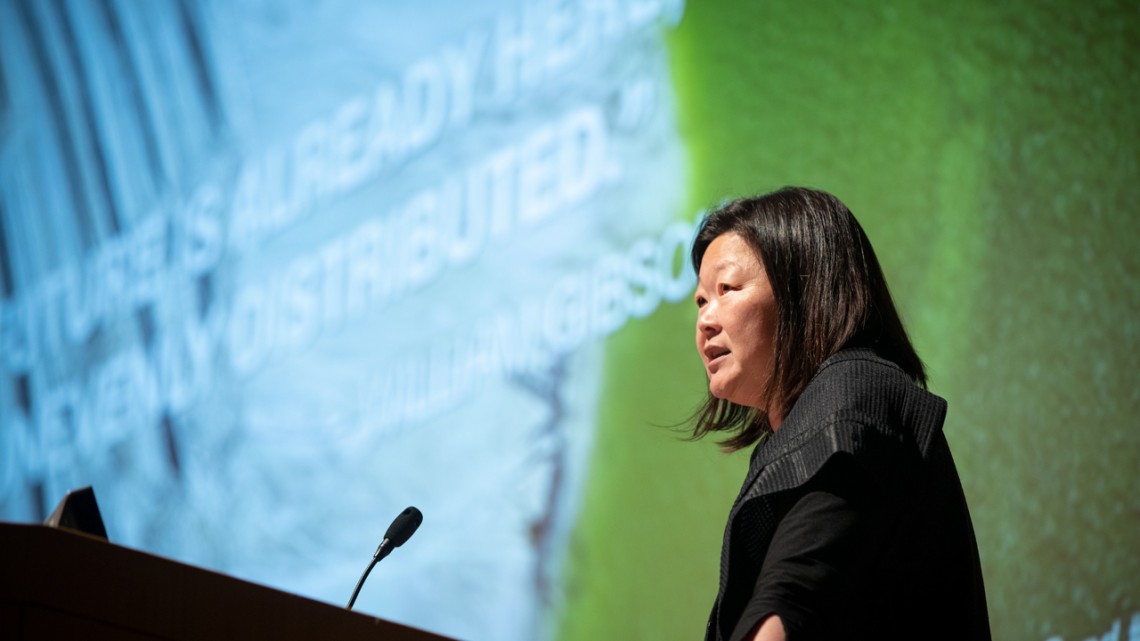
J. Meejin Yoon, B.Arch. ’95, the Gale and Ira Drukier Dean of Architecture, Art and Planning, delivers the keynote address during Cornell’s Trustee-Council Annual Meeting Oct. 18.
AAP dean shows influence, role of design in TCAM keynote
By Daniel Aloi
The possibilities, applications and impacts of design were the focus of a keynote address by J. Meejin Yoon, B.Arch. ’95, the Gale and Ira Drukier Dean of Architecture, Art and Planning, Oct. 18 during Cornell’s Trustee-Council Annual Meeting.
The talk in Alice Statler Auditorium was an opportunity to “reflect on and take stock of the state of design today as a mode of inquiry,” she said, “and speculate on what the future of design might be, could be … and, dare I say, should be.
“Design is of course by definition about future-making,” Yoon said. “It is projective, and anticipatory; and arguably, any act of design is an act of speculation into an uncertain future. If we … examine the conditions and the questions designers are grappling with today, we may have hints as to the answers.”
Accompanying her talk with a series of slides showing buildings and other projects (some by Cornell faculty), charts, illustrations, quotes and video, Yoon began with a quote from science fiction writer William Gibson: “The future is already here – it’s just not evenly distributed.”
“In order to peer into the future we need only to look deeply into our present … and often times, the future is tucked away in studios and labs on our campuses,” Yoon said. “The university not only has insights into the future, but an important role and responsibility for prototyping that future. For me, that journey began first here, as a student of architecture and design, and then at MIT as a member of the faculty.”
Yoon’s own design work and research has focused on interaction in public spaces, “and the role of technologies in the design and experiencing of public space.” Her talk incorporated some examples from Höweler + Yoon Architecture LLP, her Boston-based independent practice with Eric Höweler, B.Arch. ’94, M.Arch. ’96.
Projects such as a fiber-optic installation for the 2004 Athens Olympics, an environmentally responsive solar canopy, and complex stone structures utilizing robotic fabrication investigated “how these technologies might scale to the scale of buildings,” Yoon said.
Yoon emphasized that design ”can affect big change or be a catalyst for change.” She related current design innovations in building more sustainable structures, and discussed designing for the impacts of migration and climate change.
“Buildings are extremely resource intensive,” she said. “And while the building and architecture industries have focused on performance to achieve green standards, the operation of a building represents only 20% of the energy consumed in the full life cycle of a building.”
Of the three most commonly used materials in construction, timber is renewable and could be used more; and steel, while recyclable, is “extremely energy intensive to fabricate,” Yoon said.
“Concrete is the second-most used material on earth, only second to water. It is the most widely used construction material in the world but also the most environmentally damaging,” Yoon said. Its manufacturing alone is responsible for 5% of global carbon dioxide emissions, she said, “yet despite its environmental footprint, concrete remains the preferred choice in a rapidly urbanizing world.”
Researchers are exploring “ways to use and reuse granular materials to create structure with aggregate without cement, such that the same material can be used again and again,” she said.
The construction industry is now using mass timber and composite woods, strong materials that could “conceivably enable wood construction to reach 30-40 stories,” she said.
She cited “two exciting material and technological innovations” in the Corbel Cabin project recently completed by architecture professors Sasa Zivkovic and Leslie Lok at Cornell’s Robotic Construction Lab: robotic 3D-printed concrete, which eliminates “wasteful formwork”; and “the development of a tool that processes irregular timber stock” that would otherwise be unusable in construction.
The professors created “a new aesthetic out of a uniquely local condition,” she said – the curved geometries of trees infected by the emerald ash borer beetle.
“If the last age was the age of industrialization and physics, we have now entered into the age of biology,” Yoon said, “and many designers are looking at nature in new ways to think through our building blocks.”
One such designer is Jenny Sabin, the Arthur L. and Isabel B. Wiesenberger Professor in Architecture and AAP associate dean for design initiatives.
“Here at Cornell, Jenny Sabin is learning from biology, specifically bone structure, to imagine new ways to configure porous ceramic brick, using less material with increased strength for architectural applications,” Yoon said.
A large number of cities are facing extreme risk from climate change, and vulnerable populations migrating to them will be doubly affected, she said.
Yoon showed an informal urban settlement built on stilts in Lagos, Nigeria, along with a project there that responds to the projected risk of sea-level rise: a two-story floating school designed by architect Kunlé Adeyemi, built with wood and recycled oil drums.
“This project represents that design is not just for the 10%, but for communities who need design the most,” Yoon said. “These design solutions are modest in scale but high in impact to the communities they serve.”
Media Contact
Get Cornell news delivered right to your inbox.
Subscribe
